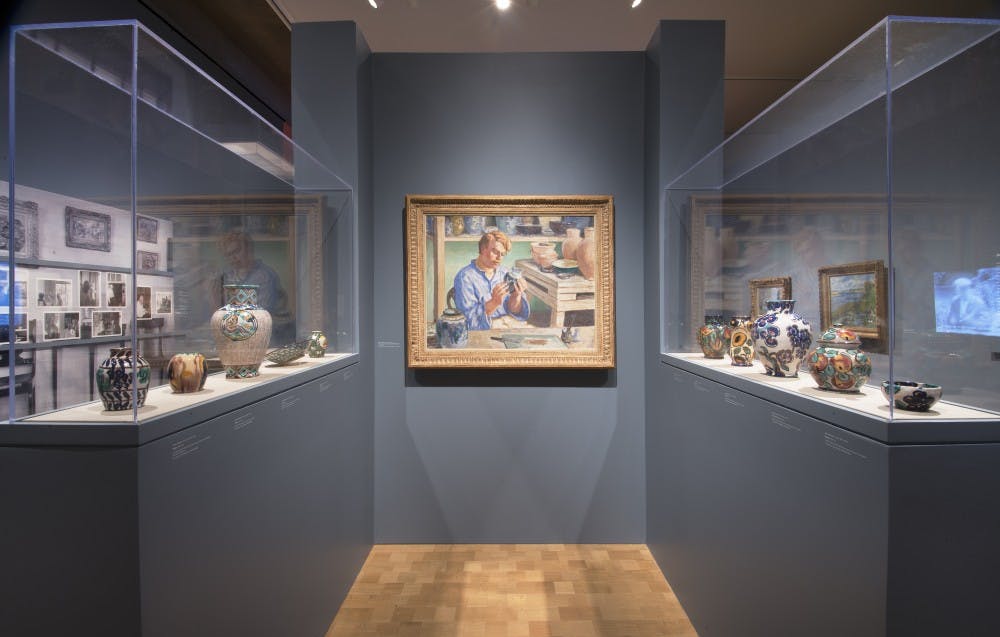Pierre-Auguste Renoir, a leader of the Impressionist movement, popularized some of the now-ubiquitous café imagery, with his piece Luncheon of the Boating Party being a subject of debate in the quirky French romance film Amélie. Now, you can see some of his most evocative work right in Center City.
A brief trip to The Barnes Foundation, or even just a look around the first gallery, betrays the collector's absolute obsession with the elder Renoir. While some museums rejected the more risqué nudes of Renoir’s late career, Dr. Barnes, whose collection created the foundation, jumped at the opportunity to purchase them. In fact, though the Barnes is known as an eclectic museum that juxtaposes art from distinct time periods and styles, it wouldn't be so far–fetched to argue that the star of the show is Renoir (though he may be tied with Matisse).
Given Barnes' infatuation with Renoir, there was truly no better place to host the special exhibition, Renoir: Father and Son / Painting and Cinema, which focuses not only on the Impressionist heavyweight, but also on his son, the cinematographer Jean Renoir. In a curatorial style that has become the Barnes Foundation’s trademark, film and painting stand next to each other, allowing for a direct comparison across generations.
Beginning with Jean’s film A Day in the Country, the exhibition draws parallels between a captivating scene of a young woman standing on a swing, and Pierre-Auguste’s painting The Swing, which is on loan from the Musée d’Orsay in Paris.
"This father-son comparison continues throughout the rest of the exhibition. Painted portraits of Catherine Hessling, who later became Jean’s first wife, are hung next to projections of the younger Renoir’s adaptation of Emile Zola’s Nana, in which she starred. And several photographs of Jean in his home show an ever-present portrait of him by Pierre-Auguste, Jean as a Huntsman, hanging on the wall behind - the only painting by his father that Jean kept throughout his entire life."

The extensive comparisons across artistic style, medium, and generation seem to suggest Jean's resistance to his father's style. Where Pierre-Auguste’s paintings are often harmonious and tranquil, Jean delved into the troubles of humanity with his films, particularly in his several depictions of failed, miserable artists instead of successful ones like his father.
Yet when there are overlaps, they are immediately obvious. In particular, Jean’s film Picnic on the Grass, which was filmed in part at the Renoir property in the south of France, the lush greenery and sensuous depiction of a nude woman bathing herself in a small river channel his father’s trademark imagery. But while Jean quietly echoed his father in this work, he still had not yet attempted a biopic or any other form of direct tribute to him.
In 1940, Jean relocated to Hollywood to continue his film career. However, he had difficulty finding work that satisfied his creative passion, and though he received an Academy Award nomination for The Southerner, critics saw this as a comparatively weak time in his career. His eventual return to Europe, and to the French imagery of his childhood, would not only bring some of Jean’s best work, but would also reaffirm some early notions he had of writing his father’s biography.
Even all of these details only scratch the surface of what Renoir: Father and Son / Painting and Cinema offers in terms of insight into the lives of two dominant Western artists. Replete with paintings, films, ceramics, letters, photographs, movie posters, and costumes, walking through the galleries is an immersive experience into the artistic culture of the time.

And something should be said for the most representative—and maybe most overlooked—aspect of the exhibition: videos of interviews with Jean Renoir himself. In these short clips, Jean shares short and nonchalant bits of cutting wisdom on the meaning and significance of art and creative passion in humanity. Two in particular stand out.
The first is from a discussion of color and imagery in his father’s later work, with Jean explaining why Pierre-Auguste continued using natural pigments when many artists had moved on to more vibrant, chemically enhanced ones.
He says that this habit went hand-in-hand with the harmoniously natural and untainted scenes that his father so adored to paint, saying that he believed “exterior events—what we’ve come to call material progress—do not contribute to what we’ve come to call happiness.” Jean expresses exactly why paintings from so long ago still have the power to move us: while so many qualities of this fast-paced world are transient, the simple and indescribable idea of happiness remains permanent.
The second, which actually appears earlier in the exhibition than the first, shows Jean describing the methods and motivations of his filmmaking. He describes how he would begin work on a film without caring too much about the end result, always trying to make sure he enjoyed the art of directing above all else.
Then he looks at the camera straight-on and says he is convinced that those who are oriented toward the final goal of a project must be unhappy, because so often we will arrive at that end and find that it was not nearly worth all of the work we gave it. Finally, in a reminder we all need in this life of constant interviews, internships, all-nighters, and an inexplicable desire for a vague sense of well–rounded perfection, he shares a phrase that captures an uncommon perspective on the way we should define happiness and success for ourselves: “What matters is the making.”
The exhibition Renoir: Father and Son / Painting and Cinema will be at the Barnes Foundation through September 3. Student tickets are $5, and include access to the permanent collection and special exhibition.







